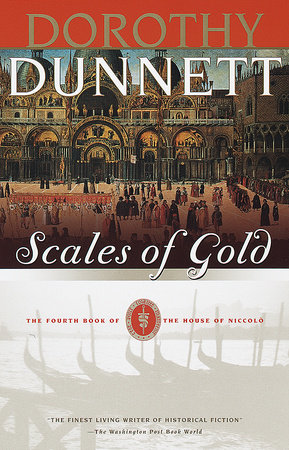Scales of Gold Reader’s Guide
By Dorothy Dunnett


1. For Discussion: Scales of Gold
In Cyprus and Trebizond, even in Bruges, Nicholas and his friends had encountered various aspects and consequences of the practice, old as history, of humans enslaving humans. During this African adventure, what new elements in this practice come to the fore? What other aspects of Dorothy’s vivid portrayal of multi-cultural, multi-geographical Africa catch your eye in this novel?
2. Why does Father Godscale want to go to Ethiopia? What is Nicholas’s final judgement about the success of this failed mission, for the priest’s own soul, and for the general community of Christians?
3. How do some of the many transformations of the African Lopez recall (or reverse?) those of Nicholas vander Poele? What for you are the deepest or most interesting aspects of this soul-friendship? Why does the plot make a significant point of Umar’s final investment in being a father?
4. Is Gelis van Borselen the heroine of Scales of Gold? In which relationship are there elements of the traditional Romance plot ? When, and why, do you think she decides to do what she reveals to Nicholas on their wedding night?
5. Spectacles–a triumph of science, commerce and art, a ‘frivolity" Nicholas calls them at his Venetian party. What symbolic and practical uses does this product serve in the novel? How do spectacles connect with and compare to another ubiquitous product, useful as gift, in trade, as symbol, in this as in the other novels–books?
6. For Discussion: The House of Niccol?
Throughout the eight books of the House of Niccol? series a picture emerges of Sophie de Fleury, the mother of Nicholas, and of her centrality in the life of her son. Can you put this picture together now –the Sophie of rumor and gossip, the Sophie of Nicholas’s slowly revealed memories, of his maturer judgement, of Andro Wodman’s reporting? Are there still some mysteries and obscurities in this portrait?
7. The House of Niccol? series offers a sustained and in many ways highly sophisticated version of the changes in intellectual , political and psychological structures which mark the transition from the medieval to the modern world. But like any good set of historical novels it abounds too in individual scenes and characters of great emotional, dramatic, and visual power, or stylistic verve, "set pieces" which hang in the memory even longer, perhaps, than the plot or the author’s philosophy of history. What are some of your favorites here–scenes of comic impact or tragic illumination? Best-drawn villain or victim, most vexatious female adolescent? Most breathtaking fight or chase? Most engrossing moment of romance? Most stunning surprise?
8. At the opening of the second volume of the series, and at the closing of the last volume, the voice of an astrologer-character replaces that of the novelist-narrator. What do you make of this–some invitation to compare and contrast those two professions?
9. Some readers will have come to the Niccol? series after reading the Lymond Chronicles, to which they are a ‘prequel’; others have now finished the Niccol? series and will go on to the sequel, the Lymond Chronicles. What are some of the dividends of doing it the first way? The second way? How (after a reading of both) are these two heroes, these two worlds, these two intricate plots, alike and different?
Just for joining you’ll get personalized recommendations on your dashboard daily and features only for members.
Find Out More Join Now Sign In